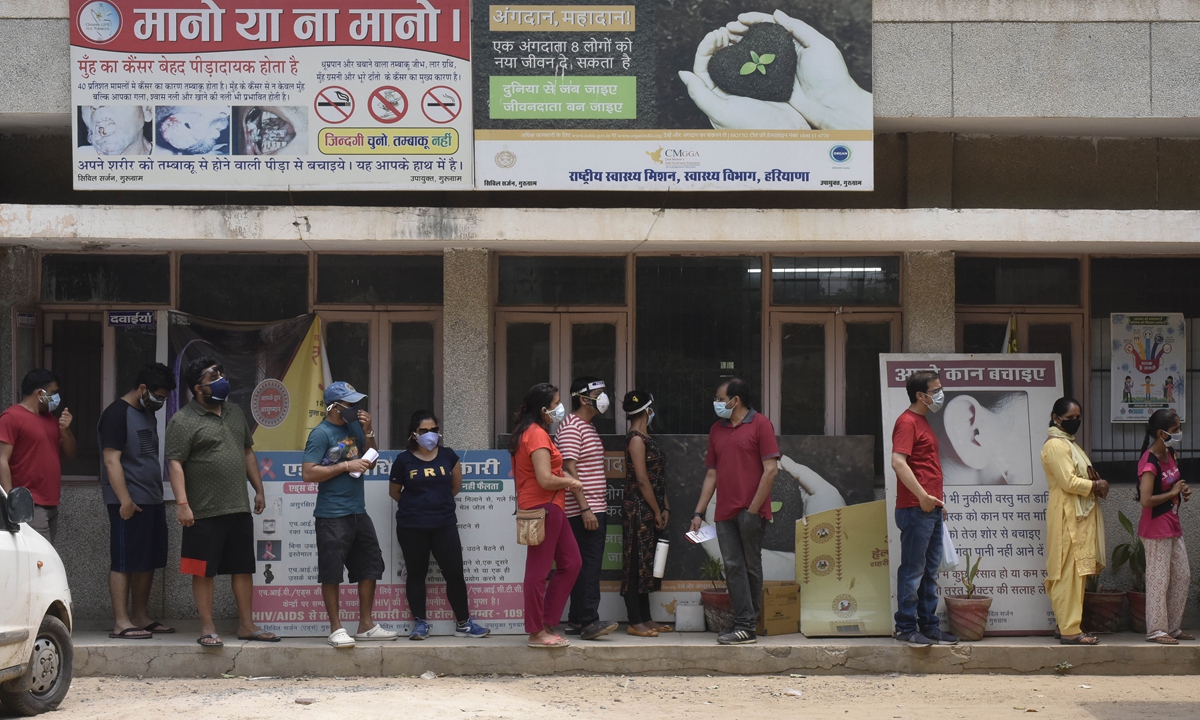
People register for Covid-19 vaccination at Tigra Urban Primary Helth Centre (UPHC), on May 7, 2021 in Gurugram, India. Photo: VCG
If the second wave of the virus has devastated India more deeply than anticipated, the long-term economic impact may be even more devastating.
More than two thirds of Indians surveyed above the age of 6 showed the presence of COVID-19 antibodies, according to the country's latest national serological survey. The result marks a dramatic jump from the previous survey, shedding light on the severity of the second wave in India.
The latest survey also appears to fuel speculation as to whether the Indian economy will suffer more severe shocks from the second wave even as it recedes.
The World Bank last month warned that South Asia risks suffering a financial crisis due to their vulnerability to growing levels of unsustainable debt. As the region's biggest economy, India is particularly exposed to sovereign debt and funding risks, especially after the pandemic drove businesses to go bankrupt and left millions unemployed.
With India is struggling to get back on track, it may find itself stuck with ballooning debt and rocketing inflation, problems that the Modi administration may have already faced for some time but which have been aggravated during the pandemic. According to data from the Reserve Bank of India, the country recorded a government debt equivalent to 69.62 percent of its GDP in the 2019-20 fiscal year. Meanwhile, India recorded retail inflation of 6.3 percent in May and 6.26 percent in June, pushing the price gauge above the central bank's 6 percent target for the first time this year. Wholesale inflation hit a record high of almost 13 percent in May, before slipping to 12 percent in June, according to media reports.
Other ominous signs about its economic difficulties may also include findings that as many as 97 percent of Indian households suffered a fall in income and the bearish performance of the Indian rupee this year.
All these have called into question whether the Modi government exerted enough prudence and efficiency when it comes to economic policy. While the Indian government has laid bare its ambition to be a manufacturing power, the progress seems limited so far. Nevertheless, during the process of promoting manufacturing, the Indian economy has become gradually dependent on the consistent inflows of Western capital.
As a result, the financial risks are piling up. Last year, the Mumbai stock market was almost one of best-performing markets in the world due to the huge inflows of the dollar, but due to concerns over prolonged economic uncertainty, foreign investors have been pulling money out of the Indian market in recent months. There are also growing concerns that once the Fed shifts monetary policy, India's economy may be trapped into a debt distress and facing shortage of the dollar.
The 1997 Asian financial crisis started in Thailand. If a similar crisis happens to India, it would likely send the regional financial markets into an even more severe mess. Governments in the region need act quickly to avert a deepening health and economic crisis.


